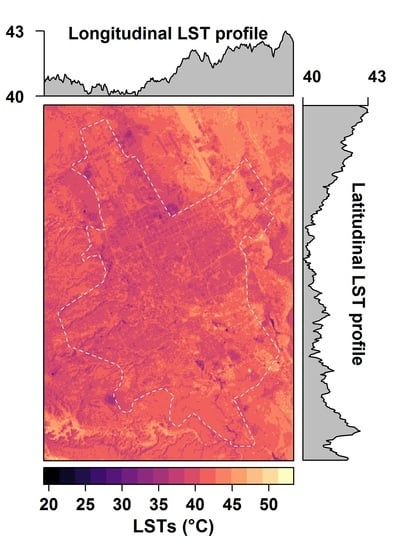Local Climate Zones and Thermal Characteristics in Riyadh City, Saudi Arabia
Abstract
:1. Introduction
2. Data and Methods
2.1. Study Area
2.2. LCZ Definition
2.3. LCZ Classification
2.4. Accuracy Assessment and Filtering
2.5. Evaluating Thermal Characteristics of LCZs Using LSTs
3. Results and Discussion
3.1. LCZ Classification
3.2. LST and LCZs
4. Summary and Conclusions
Supplementary Materials
Author Contributions
Funding
Data Availability Statement
Acknowledgments
Conflicts of Interest
Abbreviations
| Abbreviations | Full Name |
| LCLU | Land cover/use |
| LCZ | Local climate zones |
| LCZs Generator | Local climate zone generator platform/tool |
| LST | Land surface temperature |
| ROI | Region of interest |
| SUHI | Surface urban heat island |
| UG-II | Urban growth boundary limit phase II |
| UHI | Urban heat island |
| WUDAPT | World Urban Database and Access Portal Tools |
| STD | Standard deviation |
| OA | Overall accuracy |
| OAu | Overall accuracy for urban LCZ classes only |
| OAbu | Overall accuracy of the built versus land-cover LCZ classes only |
| OAw | Weighted accuracy |
References
- Wang, R.; Ren, C.; Xu, Y.; Lau, K.K.-L.; Shi, Y. Mapping the local climate zones of urban areas by GIS-based and WUDAPT methods: A case study of Hong Kong. Urban Clim. 2018, 24, 567–576. [Google Scholar] [CrossRef]
- Zheng, Y.; Ren, C.; Xu, Y.; Wang, R.; Ho, J.; Lau, K.; Ng, E. GIS-based mapping of Local Climate Zone in the high-density city of Hong Kong. Urban Clim. 2018, 24, 419–448. [Google Scholar] [CrossRef]
- Goodwin, N.R.; Coops, N.C.; Tooke, T.R.; Christen, A.; A Voogt, J. Characterizing urban surface cover and structure with airborne lidar technology. Can. J. Remote Sens. 2009, 35, 297–309. [Google Scholar] [CrossRef]
- Stewart, I.D.; Oke, T.R. Local Climate Zones for Urban Temperature Studies. Bull. Am. Meteorol. Soc. 2012, 93, 1879–1900. [Google Scholar] [CrossRef]
- Martin-Vide, J.; Sarricolea, P.; Moreno-García, M.C. On the definition of urban heat island intensity: The “rural” reference. Front. Earth Sci. 2015, 3, 24. [Google Scholar]
- Ellefsen, R. Mapping and measuring buildings in the canopy boundary layer in ten U.S. cities. Energy Build. 1991, 16, 1025–1049. [Google Scholar] [CrossRef]
- Davenport, A.G.; Grimmond, C.S.B.; Oke, T.R.; Wieringa, J. Estimating the roughness of cities and sheltered country. In Proceedings of the 12th Conference on Applied Climatology, Asheville, NC, USA, 8–11 May 2000; American Meteor Society: New York, NY, USA, 2000; Volume 96, p. 99. [Google Scholar]
- Oke, T.R. Initial guidance to obtain representative meteorological observations at urban sites. Instrum. Obs. Methods 2004, 47, 2006. [Google Scholar]
- Wang, C.; Middel, A.; Myint, S.W.; Kaplan, S.; Brazel, A.J.; Lukasczyk, J. Assessing local climate zones in arid cities: The case of Phoenix, Arizona and Las Vegas, Nevada. ISPRS J. Photogramm. Remote Sens. 2018, 141, 59–71. [Google Scholar] [CrossRef]
- Bechtel, B.; Alexander, P.J.; Böhner, J.; Ching, J.; Conrad, O.; Feddema, J.; Mills, G.; See, L.; Stewart, I. Mapping Local Climate Zones for a Worldwide Database of the Form and Function of Cities. ISPRS Int. J. Geo-Inf. 2015, 4, 199–219. [Google Scholar] [CrossRef] [Green Version]
- Xue, J.; You, R.; Liu, W.; Chen, C.; Lai, D. Applications of Local Climate Zone Classification Scheme to Improve Urban Sustainability: A Bibliometric Review. Sustainability 2020, 12, 8083. [Google Scholar] [CrossRef]
- Lehnert, M.; Savić, S.; Milošević, D.; Dunjić, J.; Geletič, J. Mapping Local Climate Zones and Their Applications in European Urban Environments: A Systematic Literature Review and Future Development Trends. ISPRS Int. J. Geo-Inf. 2021, 10, 260. [Google Scholar] [CrossRef]
- Verdonck, M.-L.; Demuzere, M.; Hooyberghs, H.; Beck, C.; Cyrys, J.; Schneider, A.; Dewulf, R.; Van Coillie, F. The potential of local climate zones maps as a heat stress assessment tool, supported by simulated air temperature data. Landsc. Urban Plan. 2018, 178, 183–197. [Google Scholar] [CrossRef]
- Kotharkar, R.; Ghosh, A.; Kotharkar, V. Estimating summertime heat stress in a tropical Indian city using Local Climate Zone (LCZ) framework. Urban Clim. 2021, 36, 100784. [Google Scholar] [CrossRef]
- Yang, X.; Peng, L.L.H.; Jiang, Z.; Chen, Y.; Yao, L.; He, Y.; Xu, T. Impact of urban heat island on energy demand in buildings: Local climate zones in Nanjing. Appl. Energy 2020, 260, 114279. [Google Scholar] [CrossRef]
- Ching, J.; Mills, G.; Bechtel, B.; See, L.; Feddema, J.; Wang, X.; Ren, C.; Brousse, O.; Martilli, A.; Neophytou, M.; et al. WUDAPT: An Urban Weather, Climate, and Environmental Modeling Infrastructure for the Anthropocene. Bull. Am. Meteorol. Soc. 2018, 99, 1907–1924. [Google Scholar] [CrossRef] [Green Version]
- Mushore, T.D.; Dube, T.; Manjowe, M.; Gumindoga, W.; Chemura, A.; Rousta, I.; Odindi, J.; Mutanga, O. Remotely sensed retrieval of Local Climate Zones and their linkages to land surface temperature in Harare metropolitan city, Zimbabwe. Urban Clim. 2019, 27, 259–271. [Google Scholar] [CrossRef]
- Verdonck, M.L.; Okujeni, A.; van der Linden, S.; Demuzere, M.; De Wulf, R.; Van Coillie, F. Influence of neighbourhood information on ‘Local Climate Zone’ mapping in heterogeneous cities. Int. J. Appl. Earth Obs. Geoinf. 2017, 62, 102–113. [Google Scholar] [CrossRef]
- Fricke, C.; Pongrácz, R.; Gál, T.; Savić, S.; Unger, J. Using local climate zones to compare remotely sensed surface temperatures in temperate cities and hot desert cities. Morav. Geogr. Rep. 2020, 28, 48–60. [Google Scholar] [CrossRef]
- Demuzere, M.; Kittner, J.; Bechtel, B. LCZ Generator: A Web Application to Create Local Climate Zone Maps. Front. Environ. Sci. 2021, 9. [Google Scholar] [CrossRef]
- Alghamdi, A.S.; Moore, T.W. Detecting temporal changes in Riyadh’s urban heat island. Appl. Geogr. 2015, 1, 312–325. [Google Scholar] [CrossRef]
- Bakarman, M.A.; Chang, J.D. The Influence of Height/width Ratio on Urban Heat Island in Hot-arid Climates. Procedia Eng. 2015, 118, 101–108. [Google Scholar] [CrossRef]
- Aina, Y.A.; Adam, E.M.; Ahmed, F. Spatiotemporal variations in the impacts of urban land use types on urban heat island effects: The case of Riyadh, Saudi Arabia. Int. Arch. Photogramm. Remote Sens. Spat. Inf. Sci. 2017, 42, 9–14. [Google Scholar] [CrossRef] [Green Version]
- Eldesoky, A.H.; Gil, J.; Pont, M.B. The suitability of the urban local climate zone classification scheme for surface temperature studies in distinct macroclimate regions. Urban Clim. 2021, 37, 100823. [Google Scholar] [CrossRef]
- Alqurashi, A.F.; Kumar, L.; Sinha, P. Urban Land Cover Change Modelling Using Time-Series Satellite Images: A Case Study of Urban Growth in Five Cities of Saudi Arabia. Remote Sens. 2016, 8, 838. [Google Scholar] [CrossRef] [Green Version]
- Rahman, M.T.; Planning, R. Land use and land cover changes and urban sprawl in Riyadh, Saudi Arabia: An analysis using multi-temporal Landsat data and Shannon’s Entropy Index. Int. Arch. Photogramm. Remote Sens. Spat. Inf. Sci. 2016, 41, 1017–1021. [Google Scholar] [CrossRef] [Green Version]
- Aina, Y.A.; Adam, E.; Ahmed, F.; Wafer, A.; Alshuwaikhat, H.M. Using multisource data and the V-I-S model in assessing the urban expansion of Riyadh city, Saudi Arabia. Eur. J. Remote Sens. 2019, 52, 557–571. [Google Scholar] [CrossRef] [Green Version]
- Alghamdi, A.; Cummings, A.R. Assessing Riyadh’s Urban Change Utilizing High-Resolution Imagery. Land 2019, 8, 193. [Google Scholar] [CrossRef] [Green Version]
- AlQurashi, A.F.; Kumar, L. An assessment of the impact of urbanization and land use changes in the fast-growing cities of Saudi Arabia. Geocarto Int. 2017, 34, 78–97. [Google Scholar] [CrossRef]
- Altuwaijri, H.A.; Alotaibi, M.H.; Almudlaj, A.M.; Almalki, F.M. Predicting urban growth of Arriyadh city, capital of the Kingdom of Saudi Arabia, using Markov cellular automata in TerrSet geospatial system. Arab. J. Geosci. 2019, 12, 135. [Google Scholar] [CrossRef]
- Alkolibi, F.M. Possible Effects of Global Warming on Agriculture and Water Resources in Saudi Arabia: Impacts and Responses. Clim. Chang. 2002, 54, 225–245. [Google Scholar] [CrossRef]
- Sobrino, J.A.; Irakulis, I. A Methodology for Comparing the Surface Urban Heat Island in Selected Urban Agglomerations Around the World from Sentinel-3 SLSTR Data. Remote Sens. 2020, 12, 2052. [Google Scholar] [CrossRef]
- Nasrallah, H.A.; Brazel, A.J.; Balling, R.C., Jr. Analysis of the Kuwait City urban heat island. International Journal of Climatology 1990, 10, 401–405. [Google Scholar] [CrossRef]
- Chen, X.-L.; Zhao, H.-M.; Li, P.-X.; Yin, Z.-Y. Remote sensing image-based analysis of the relationship between urban heat island and land use/cover changes. Remote Sens. Environ. 2006, 104, 133–146. [Google Scholar] [CrossRef]
- Ren, C.; Cai, M.; Li, X.; Zhang, L.; Wang, R.; Xu, Y.; Ng, E.Y.Y. Assessment of Local Climate Zone Classification Maps of Cities in China and Feasible Refinements. Sci. Rep. 2019, 9, 1–11. [Google Scholar] [CrossRef] [Green Version]
- Radoux, J.; Lamarche, C.; Van Bogaert, E.; Bontemps, S.; Brockmann, C.; Defourny, P. Automated Training Sample Extraction for Global Land Cover Mapping. Remote Sens. 2014, 6, 3965–3987. [Google Scholar] [CrossRef] [Green Version]
- Demuzere, M.; Hankey, S.; Mills, G.; Zhang, W.; Lu, T.; Bechtel, B. Combining expert and crowd-sourced training data to map urban form and functions for the continental US. Sci. Data 2020, 7, 1–13. [Google Scholar] [CrossRef]
- Bechtel, B.; Demuzere, M.; Mills, G.; Zhan, W.; Sismanidis, P.; Small, C.; Voogt, J. SUHI analysis using Local Climate Zones—A comparison of 50 cities. Urban Clim. 2019, 28, 100451. [Google Scholar] [CrossRef]
- Malakar, N.K.; Hulley, G.C.; Hook, S.J.; Laraby, K.; Cook, M.; Schott, J.R. An Operational Land Surface Temperature Product for Landsat Thermal Data: Methodology and Validation. IEEE Trans. Geosci. Remote Sens. 2018, 56, 5717–5735. [Google Scholar] [CrossRef]
- USGS. Landsat 8-9 Calibration and Validation (Cal/Val) Algorithm Description Document (ADD). 2021. Available online: https://prd-wret.s3.us-west-2.amazonaws.com/assets/palladium/production/atoms/files/LSDS-1747_Landsat8-9_CalVal_ADD-v4.pdf (accessed on 14 August 2021).
- Massey, F.J., Jr. The Kolmogorov-Smirnov test for goodness of fit. J. Am. Stat. Assoc. 1951, 46, 68–78. [Google Scholar] [CrossRef]
- Zhao, C.; Jensen, J.; Weng, Q.; Currit, N.; Weaver, R. Application of airborne remote sensing data on mapping local climate zones: Cases of three metropolitan areas of Texas, U.S. Comput. Environ. Urban Syst. 2019, 74, 175–193. [Google Scholar] [CrossRef]
- Pan, X.; Zhu, X.; Yang, Y.; Cao, C.; Zhang, X.; Shan, L. Applicability of Downscaling Land Surface Temperature by Using Normalized Difference Sand Index. Sci. Rep. 2018, 8, 1–14. [Google Scholar] [CrossRef] [Green Version]
- Du, P.; Chen, J.; Bai, X.; Han, W. Understanding the seasonal variations of land surface temperature in Nanjing urban area based on local climate zone. Urban Clim. 2020, 33, 100657. [Google Scholar] [CrossRef]
- Zhao, C.; Jensen, J.L.R.; Weng, Q.; Currit, N.; Weaver, R. Use of Local Climate Zones to investigate surface urban heat islands in Texas. GIScience Remote Sens. 2020, 57, 1083–1101. [Google Scholar] [CrossRef]
- Abulibdeh, A. Analysis of urban heat island characteristics and mitigation strategies for eight arid and semi-arid gulf region cities. Environ. Earth Sci. 2021, 80, 1–26. [Google Scholar] [CrossRef] [PubMed]
- Li, N.; Yang, J.; Qiao, Z.; Wang, Y.; Miao, S. Urban Thermal Characteristics of Local Climate Zones and Their Mitigation Measures across Cities in Different Climate Zones of China. Remote Sens. 2021, 13, 1468. [Google Scholar] [CrossRef]
- Kwarteng, A.Y.; Small, C.L. Comparative analysis of thermal environments in New York City and Kuwait City. In Proceedings of the Remote Sensing of Urban Areas, Tempe, AZ, USA, 14–16 March 2005. [Google Scholar]
- Brousse, O.; Georganos, S.; Demuzere, M.; Dujardin, S.; Lennert, M.; Linard, C.; Snow, R.W.; Thiery, W.; Van Lipzig, N.P.M. Can we use local climate zones for predicting malaria prevalence across sub-Saharan African cities? Environ. Res. Lett. 2020, 15, 124051. [Google Scholar] [CrossRef]
- Collins, J.; Dronova, I. Urban Landscape Change Analysis Using Local Climate Zones and Object-Based Classification in the Salt Lake Metro Region, Utah, USA. Remote Sens. 2019, 11, 1615. [Google Scholar] [CrossRef] [Green Version]
- Li, X.; Zhou, W.; Ouyang, Z. Relationship between land surface temperature and spatial pattern of greenspace: What are the effects of spatial resolution? Landsc. Urban Plan. 2013, 114, 1–8. [Google Scholar] [CrossRef]
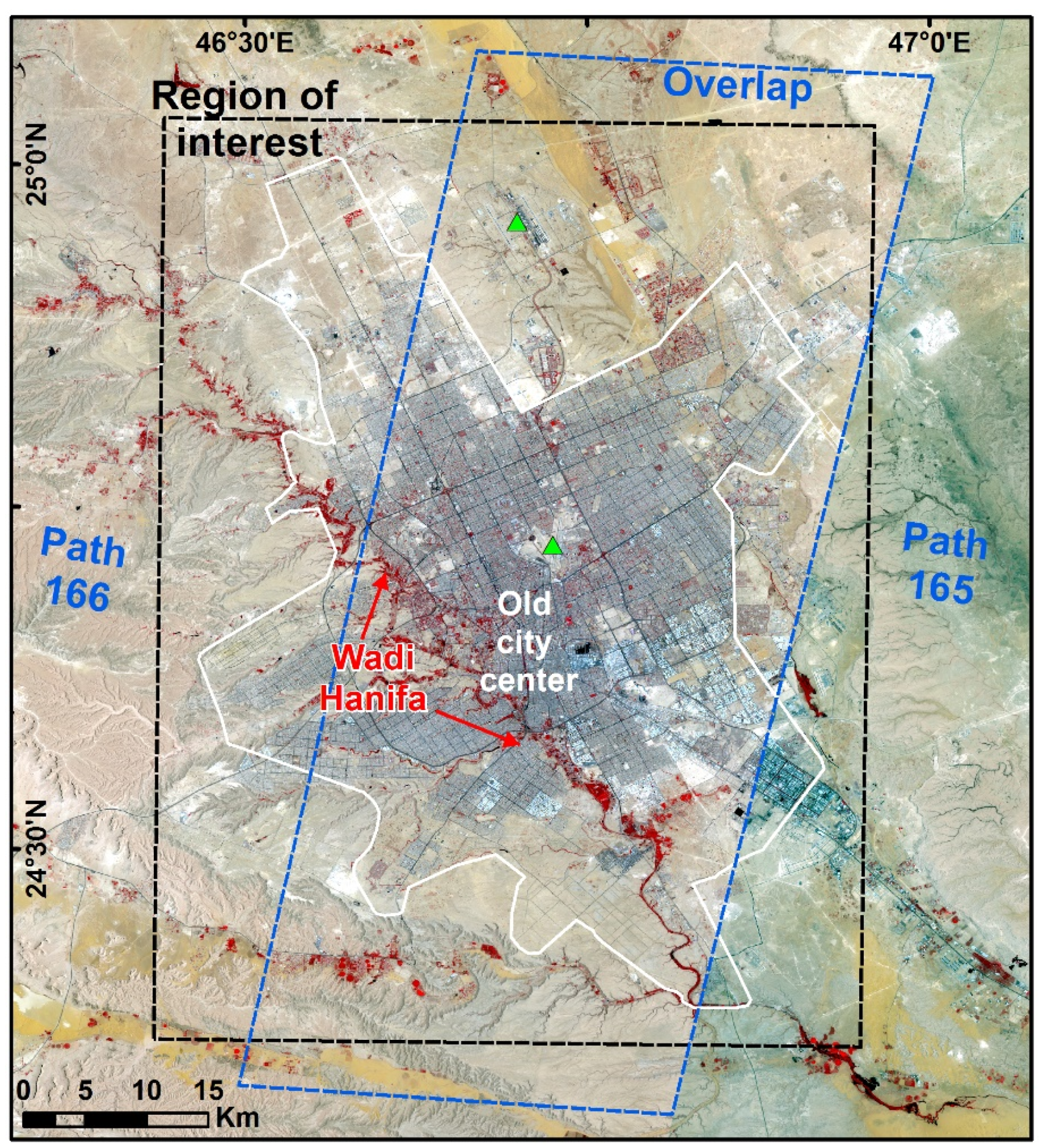
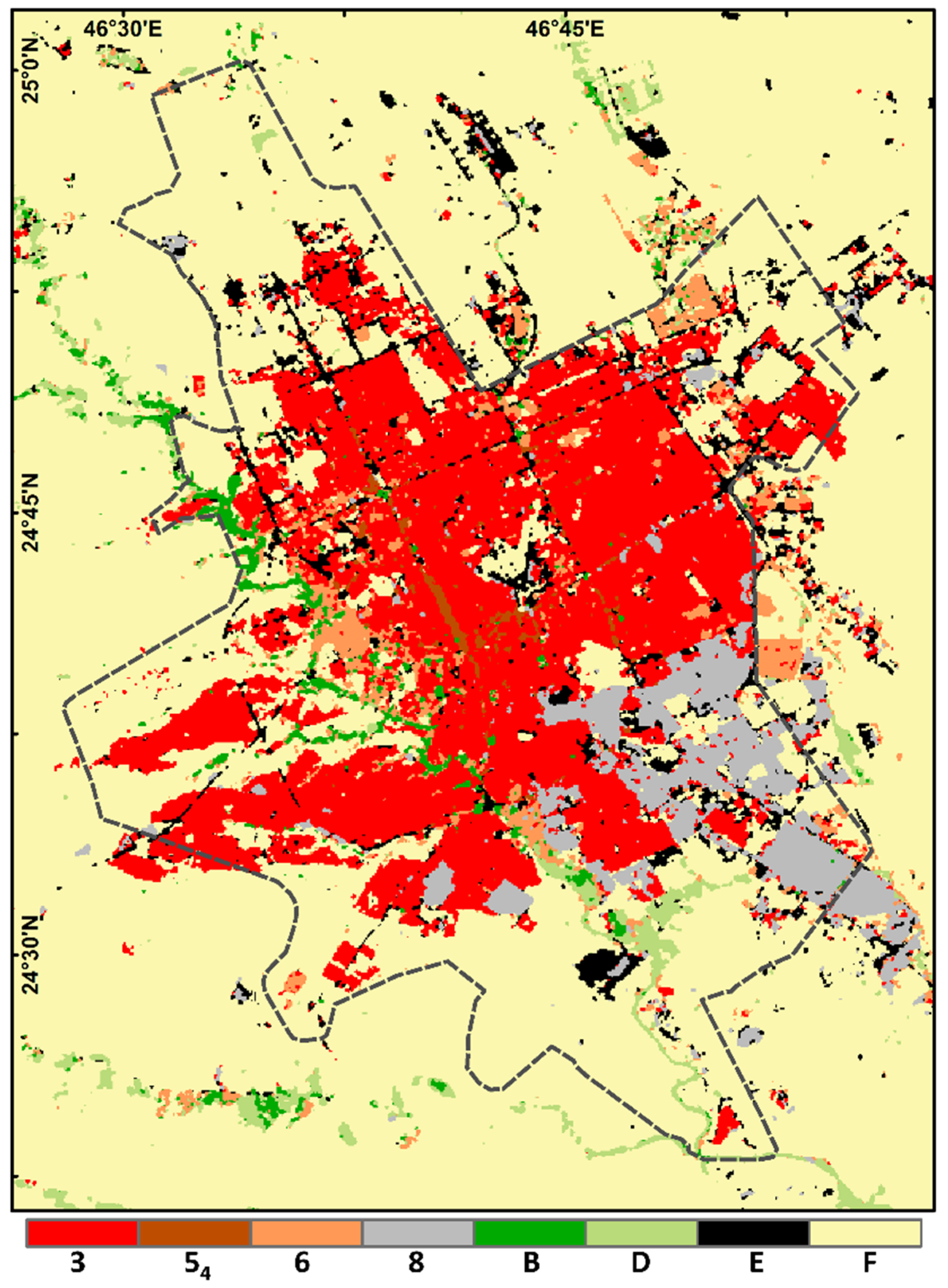
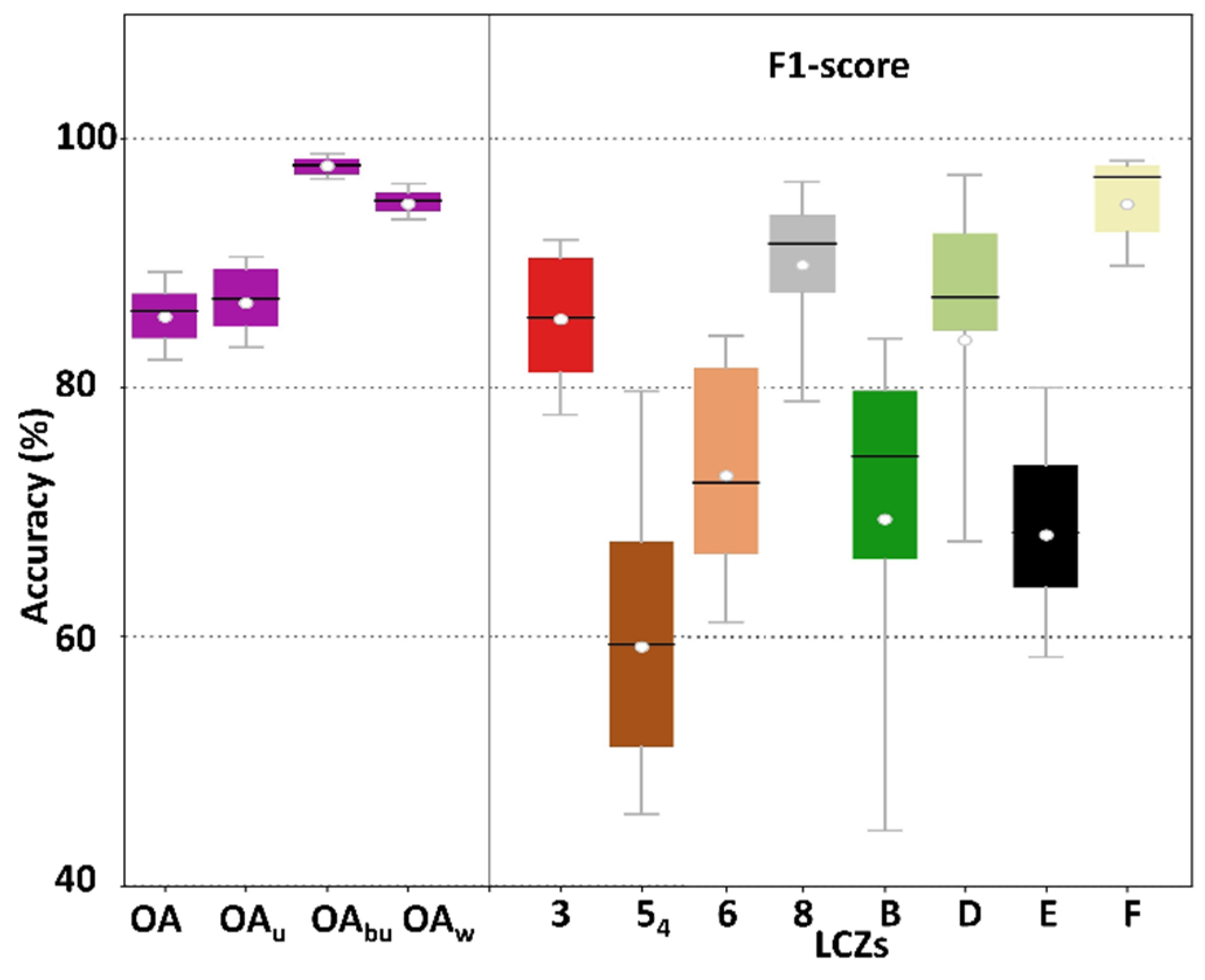
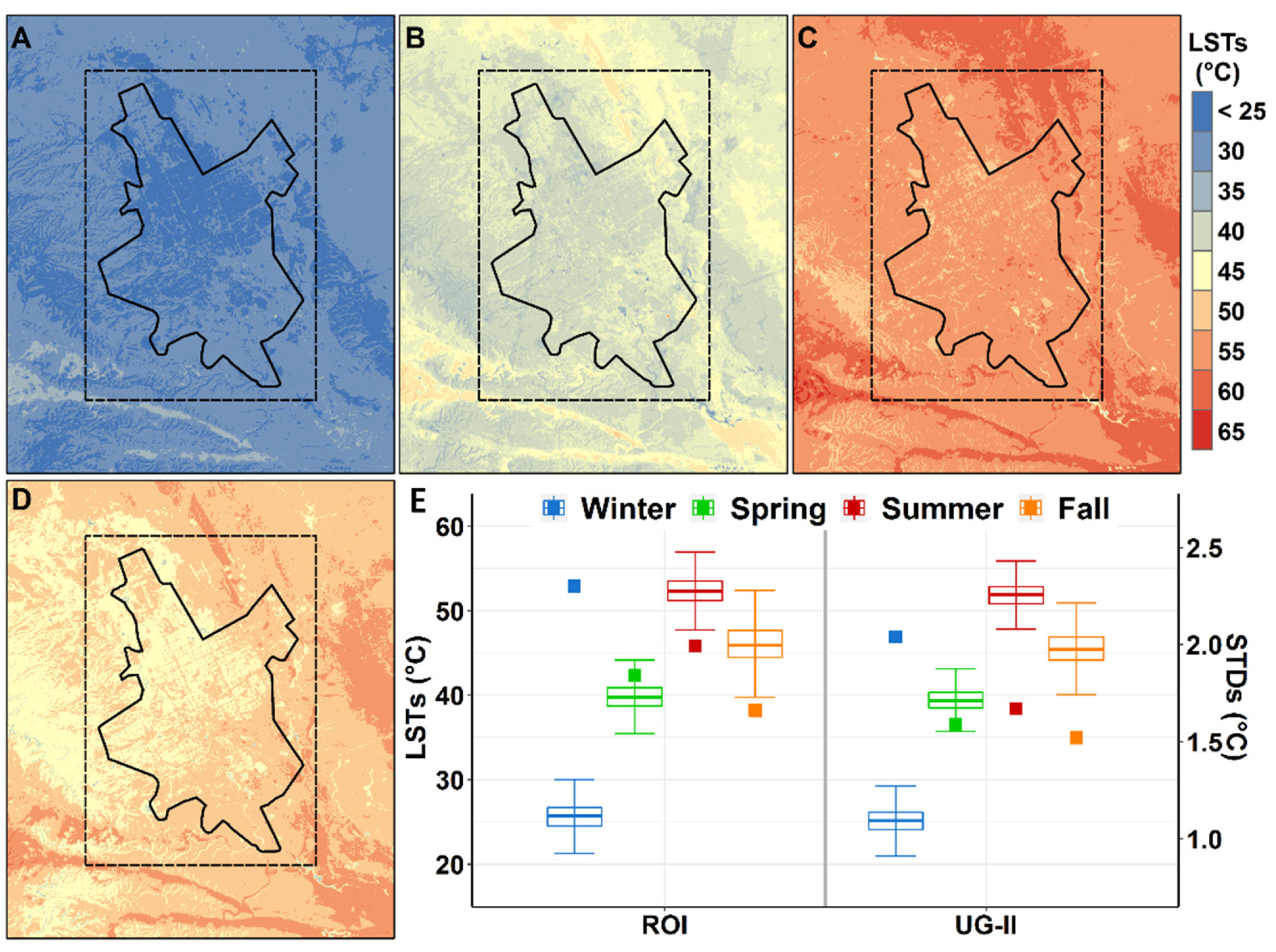
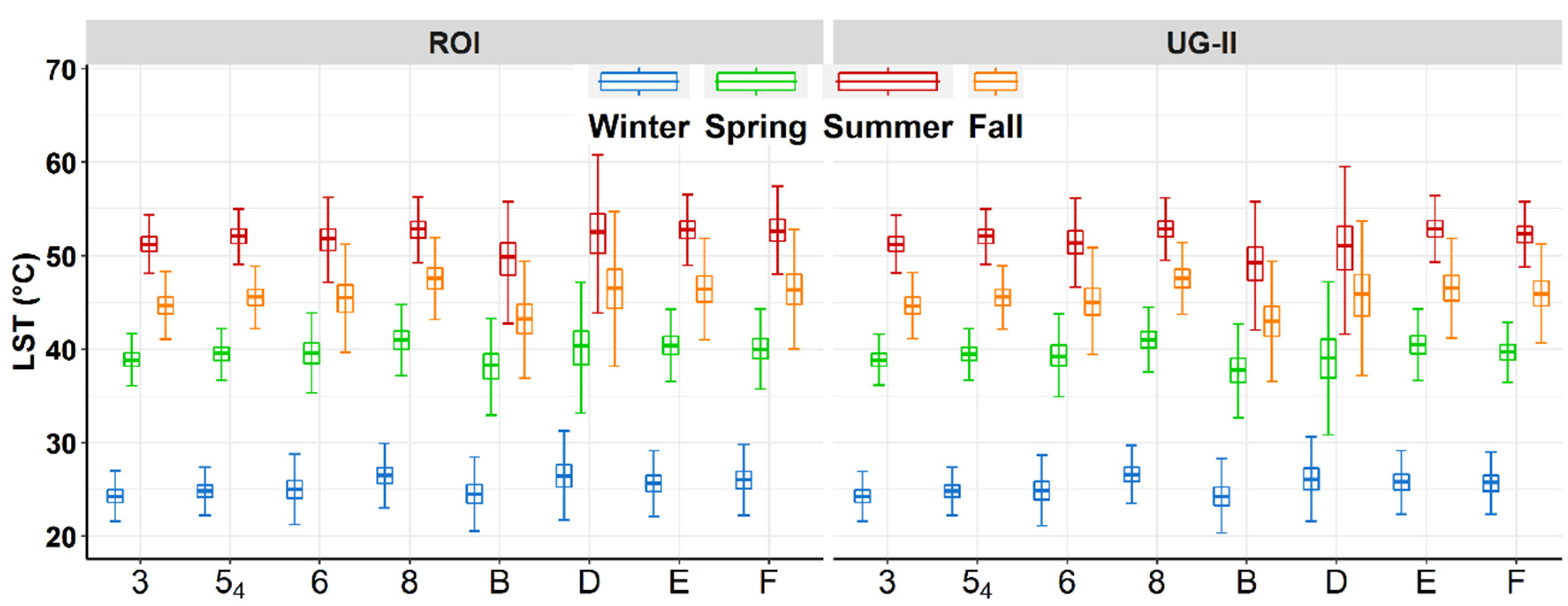
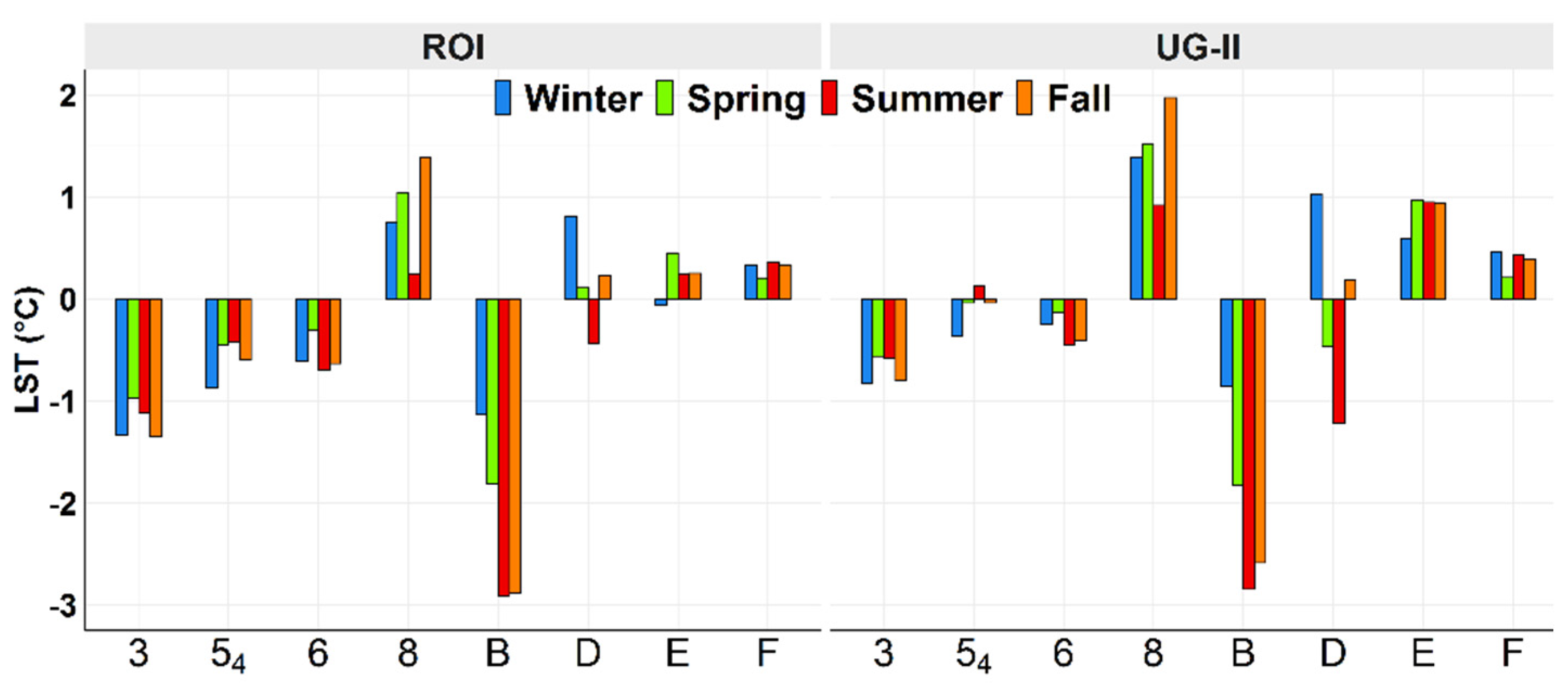

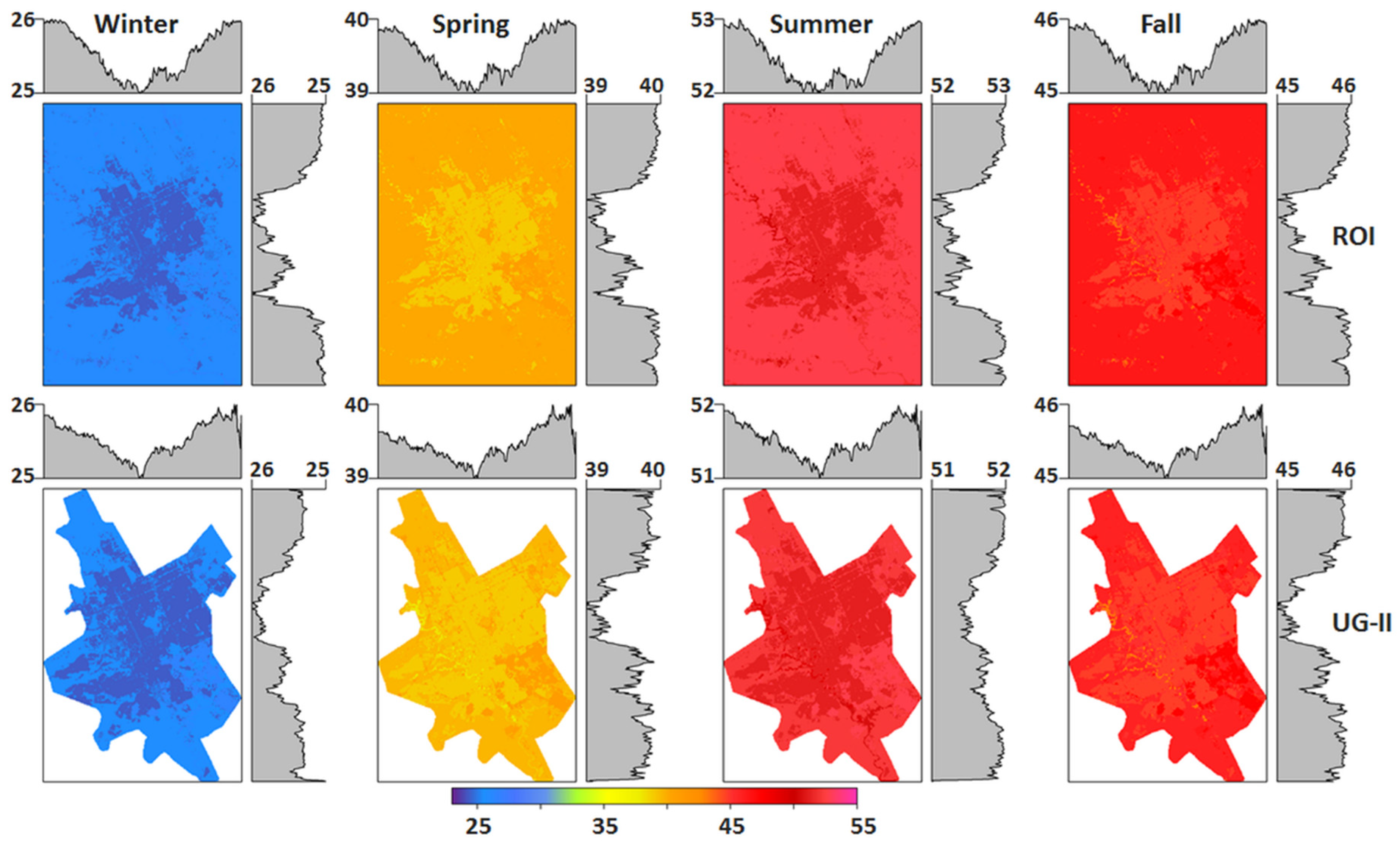

| Season | Precip (mm) | Tmean (°C) | Tmax (°C) | Tmin (°C) |
|---|---|---|---|---|
| Winter | 11.2 | 15.9 | 22.4 | 9.4 |
| Spring | 22.4 | 27.1 | 33.9 | 19.9 |
| Summer | 0.1 | 35.5 | 43.4 | 27.3 |
| Fall | 2.7 | 27.8 | 34.8 | 20.0 |
| LCZs | Description |
|---|---|
| LCZ-3 Compact low-rise | Closely spaced buildings 1–3 stories tall. |
| LCZ-54 Open midrise with Open high-rise | Open arrangement of buildings ≥ 3 stories tall. |
| LCZ-6 Open low-rise | Open arrangement of buildings 1–3 stories tall. |
| LCZ-8 Large low-rise | Large and low buildings 1–3 stories (e.g., warehousing, and shopping centers). |
| LCZ-B Scattered trees | Parks and agricultural lands with frequent trees. |
| LCZ-D Low plants | Agricultural lands and grassy parks |
| LCZ-E Bare rock/paved | Impervious ground (e.g., bedrock, asphalt, and concrete). |
| LCZ-F bare soil/sand | Pervious ground and land with construction in progress. |
| Season | Acquisition Date | Path/Row | Acquisition Date | Path/Row |
|---|---|---|---|---|
| Summer | 20170605 (0.0) | 166/43 | 20170723 (0.0) | 166/43 |
| 20170614 (0.0) | 165/43 | 20170801 (0.0) | 165/43 | |
| 20170621 (0.0) | 166/43 | 20170808 (0.0) | 166/43 | |
| 20170630 (0.0) | 165/43 | 20170817 (0.0) | 165/43 | |
| 20170707 (2.1) | 166/43 | 20170824 (0.5) | 166/43 | |
| 20170716 (0.0) | 165/43 | |||
| Fall | 20170902 (0.0) | 165/43 | 20171011 (0.0) | 166/43 |
| 20170909 (0.3) | 166/43 | 20171020 (0.0) | 165/43 | |
| 20170918 (0.0) | 165/43 | 20171027 (0.0) | 166/43 | |
| 20170925 (0.0) | 166/43 | 20171105 (4.4) | 165/43 | |
| 20171004 (0.0) | 165/43 | 20171112 (0.04) | 166/43 | |
| Winter | 20171207 (0.7) | 165/43 | 20180115 (0.3) | 166/43 |
| 20171214 (0.4) | 166/43 | 20180124 (1.5) | 165/43 | |
| 20171223 (2.5) | 165/43 | 20180131 (1.8) | 166/43 | |
| 20171230 (0.3) | 166/43 | 20180209 (0.7) | 165/43 | |
| 20180108 (0.8) | 165/43 | 20180216 (0.3) | 166/43 | |
| Spring | 20180523 (0.0) | 166/43 | 20180414 (0.0) | 165/43 |
| 20180507 (0.3) | 166/43 | 20180329 (0.1) | 165/43 | |
| 20180430 (0.0) | 165/43 | 20180320 (1.1) | 166/43 | |
| 20180421 (0.0) | 166/43 | 20180313 (0.1) | 165/43 | |
| 20180304 (0.1) | 166/43 |
| LCZ | ROI | UG-II | ||
|---|---|---|---|---|
| Area | (%) | Area | (%) | |
| 3 | 685 | 18 | 657 | 37 |
| 54 | 17 | <1 | 17 | 1 |
| 6 | 114 | 3 | 77 | 4 |
| 8 | 156 | 4 | 124 | 7 |
| B | 46 | 1 | 30 | 2 |
| D | 79 | 2 | 26 | 2 |
| E | 167 | 4 | 111 | 6 |
| F | 2633 | 68 | 714 | 41 |
| Total | 3897 | 100 | 1756 | 100 |
Publisher’s Note: MDPI stays neutral with regard to jurisdictional claims in published maps and institutional affiliations. |
© 2021 by the authors. Licensee MDPI, Basel, Switzerland. This article is an open access article distributed under the terms and conditions of the Creative Commons Attribution (CC BY) license (https://creativecommons.org/licenses/by/4.0/).
Share and Cite
Alghamdi, A.S.; Alzhrani, A.I.; Alanazi, H.H. Local Climate Zones and Thermal Characteristics in Riyadh City, Saudi Arabia. Remote Sens. 2021, 13, 4526. https://doi.org/10.3390/rs13224526
Alghamdi AS, Alzhrani AI, Alanazi HH. Local Climate Zones and Thermal Characteristics in Riyadh City, Saudi Arabia. Remote Sensing. 2021; 13(22):4526. https://doi.org/10.3390/rs13224526
Chicago/Turabian StyleAlghamdi, Ali S., Ahmed Ibrahim Alzhrani, and Humud Hadi Alanazi. 2021. "Local Climate Zones and Thermal Characteristics in Riyadh City, Saudi Arabia" Remote Sensing 13, no. 22: 4526. https://doi.org/10.3390/rs13224526
APA StyleAlghamdi, A. S., Alzhrani, A. I., & Alanazi, H. H. (2021). Local Climate Zones and Thermal Characteristics in Riyadh City, Saudi Arabia. Remote Sensing, 13(22), 4526. https://doi.org/10.3390/rs13224526





